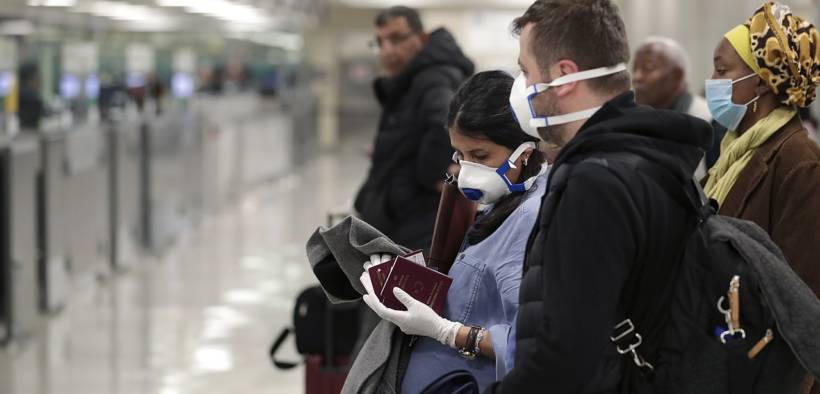Here’s How We Can Solve COVID-19 in 28 Days

COVID-19 is the first global pandemic of the internet era. Information is now transferred at the speed of light rather than the speed of Morse code. This gives us a big advantage over our ancestors—if we use it effectively.
The virus crosses national borders, so our response must do the same. We need a global mobilization for everyone on our planet to wear masks for 28 days, two cycles of the viral incubation period of 14 days. Alongside physical distancing and frequent handwashing, this is the fastest way to eliminate COVID-19.
While the entire world is experiencing the COVID-19 pandemic, not every country’s experience is the same. Some countries have far lower transmission and death rates per capita than others. These countries have one very important thing in common: nearly universal adoption of mask-wearing.
With cultural adoption of facial masks, the SARS-CoV-2 virus is far less likely to transmit from person-to-person. This greatly decreases the potential for the virus to infect the most vulnerable persons, including seniors and the immunocompromised. Thus, a campaign for the worldwide use of masks is the fastest way toward eliminating COVID-19 in less than 30 days.
Herd immunity to viruses can be generated in one of two ways: Either through viral transmission through a non-immune population or through an effective vaccine. Viral transmission through a non-immune population has inherent risks, including an unacceptable amount of (preventable) deaths. Waiting for a vaccine to be developed can last years. Even if a vaccine is developed, vaccinating the entirety of the globe—7.8 billion people—will be time and labor intensive.
Fortunately, data is emerging that when the majority of a population wears masks, the transmission of SARS-CoV-2 is significantly reduced. If the entire global population wears masks for 28 days, we can virtually eliminate the SARS-CoV-2 virus.
It is increasingly clear that SARS-CoV-2 transmits primarily via respiratory droplets. When an individual sneezes, laughs, sings, talks, or simply breathes, these droplets can travel into another individual’s mouth or nose and establish an infection.
Masks are essential because they block those respiratory droplets. Research suggests that people with COVID-19 are most infectious in the beginning of their illness, well before they know that they are sick. This is why everyone, not just those who are feeling sick, needs to wear masks. If masks are worn universally for 28 days, the virus can be eliminated far more rapidly than having to wait for herd immunity or a vaccine.
Scientific literature describes how well masks capture and contain departing mouth spittle. The mask acts like a barrier preventing the atomization of droplets, the primary means of transport of the SARS-CoV-2 virus. The good news is, this doesn’t just apply to medical grade masks. Homemade masks, which can be created from materials like old clothes, dish rags, and pillows, are very effective at reducing viral transmission.
Controlling the virus at the source of exit has the potential to significantly decrease the likelihood of transmission to the point that the virus cannot sustain itself. Without a circulating virus, there is no pandemic. Masks up, COVID down.
Looking at things from the perspective of a virus, its existential purpose is to replicate its genes in a host, make copies of itself, and then infect the next host. Wash, rinse, repeat until you have a pandemic. This is the fundamental premise of any viral outbreak: the virus is genetically programmed to replicate and infect person-after-person. Once the last person has been infected and the virus has run out of people to infect, it literally vanishes. Herd immunity has been achieved.
This isn’t just theoretical. Weakening the ability of viruses to transmit to new hosts has worked extremely effectively in the past. During the 1990s, the HIV epidemic was devastating Brazil—so much so the World Bank estimated 1.2 million cases by the year 2000. Through an intensive condom education campaign by the end of 2003, the number had grown by less than one percent, to 660,000. The spread of the HIV virus was mostly halted due to condoms interrupting its ability to transmit from person-to-person.
In 1840s Austria, 13–18 percent of women were dying in childbirth. Dr. Ignaz Semmelweis implemented a new policy, requiring doctors to wash their hands before delivering babies. As a result, the mortality rate for women in childbirth dropped to two percent. Handwashing is such a simple step, yet it has saved millions of lives!
From our modern-day perspective, washing our hands is an easy and commonsense way to avoid illness. All of us, across national borders, must treat mask-wearing the exact same way. Putting on our masks is a basic step we’re taking to protect ourselves and others. If we all take that simple step, we can eradicate COVID-19.
This article was produced by Economy for All, a project of the Independent Media Institute.
















What is “the speed of Morse code”?